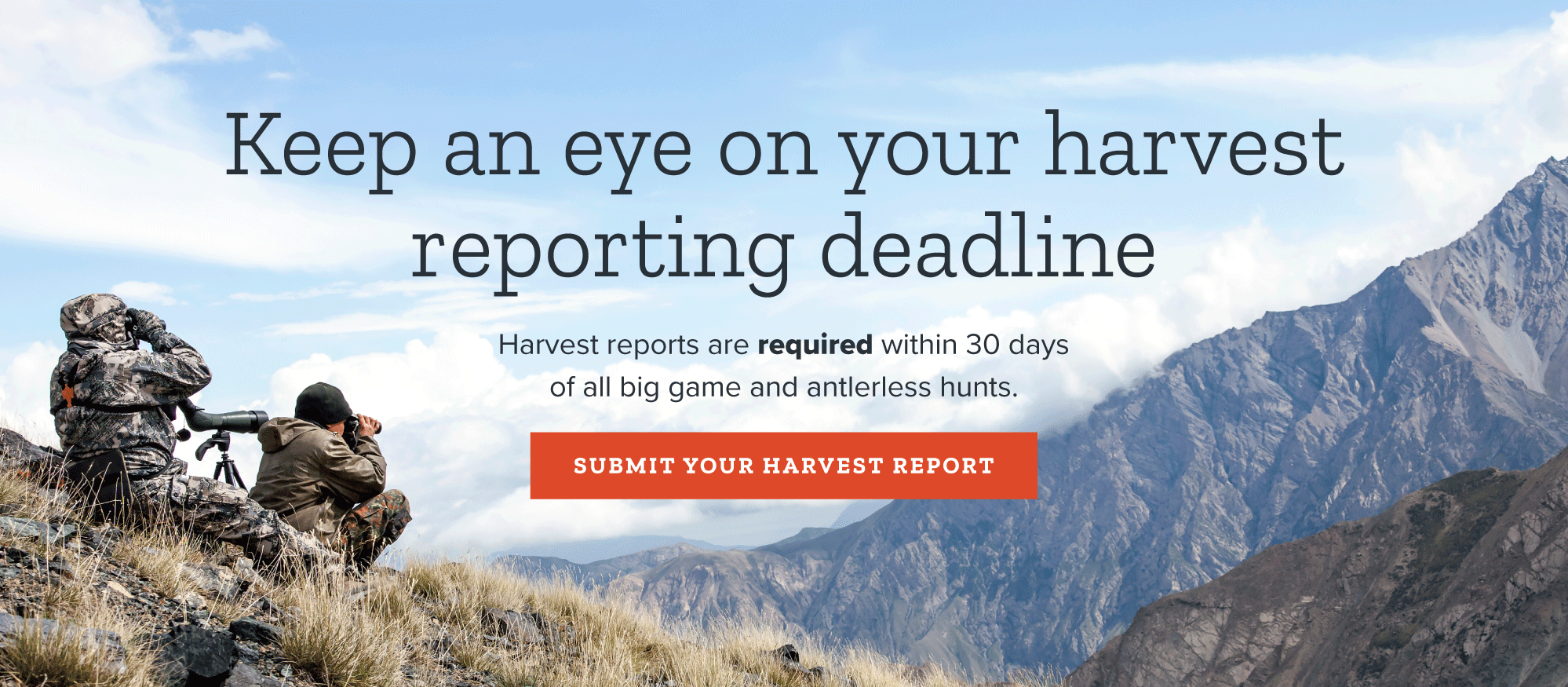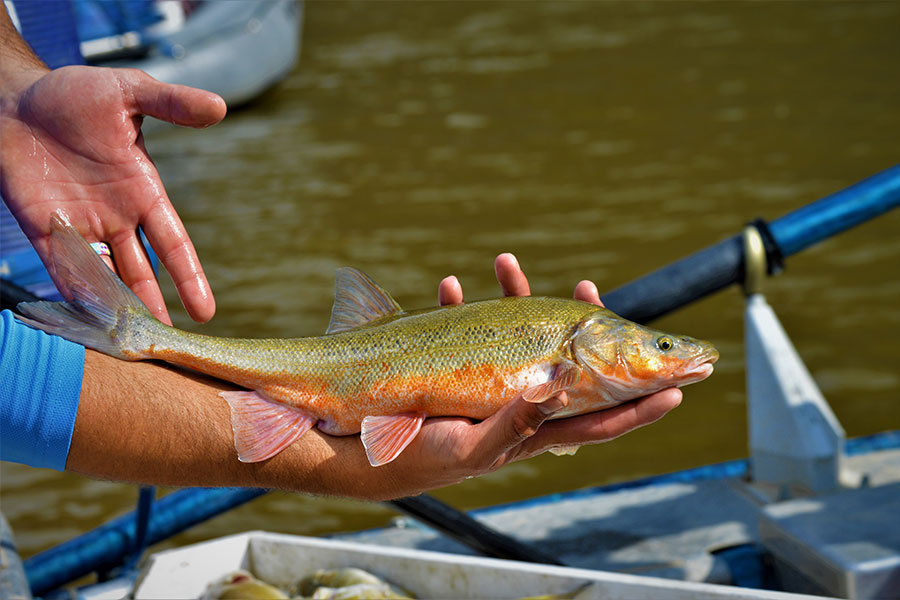DWR proposes classifying roundtail chub as a sportfish, other changes to fishing regulations
Salt Lake City — The Utah Division of Wildlife Resources is proposing changes to fishing regulations across the state, including classifying roundtail chub as a sportfish and establishing fishing regulations for the species. A few other changes are also being recommended, and the DWR is asking for the public's feedback on the proposals.
2023–24 fishing recommendations
The DWR makes changes to fishing regulations when data collected from biological surveys or angler catch data shows that a fishery is not meeting its objectives. The DWR also conducts an online survey to gauge public support for all regulation changes before formally recommending them to the Regional Advisory Councils and the Utah Wildlife Board.
"One of our proposals for this next year's fishing regulations is to remove roundtail chub from the list of prohibited fish species to fish for in Utah," DWR Sportfish Coordinator Randy Oplinger said. "We initially started presenting this idea to the public last year, and there was a lot of support for it. These are a fun species to fish for because they take a wide variety of flies, lures and baits. While roundtail chub are considered a species of greatest conservation need, they are a conservation success story and their populations in Utah are doing well enough now to withstand some fishing pressure."
The proposed change would allow roundtail chub to be caught in the following areas:
- Escalante River: From the confluence of Pine Creek downriver to the confluence of Lake Powell. All roundtail chub must be immediately released after being caught, and only artificial flies and lures could be used.
- McElmo Creek: From the Colorado state line downriver to the confluence of the San Juan River. All roundtail chub must be immediately released after being caught, and only artificial flies and lures could be used.
- Colorado River: From the Colorado state line downriver to the confluence of the Dirty Devil River. There would be a daily fish limit of two roundtail chub.
- Delores River: From the Colorado state line downriver to the confluence of the Colorado River. There would be a daily fish limit of two roundtail chub.
- Green River: From the Colorado state line downriver to Sand Wash boat launch. All roundtail chub must be immediately released.
- Green River: From the Sand Wash boat launch downriver to the confluence of the Colorado River. There would be a daily fish limit of two roundtail chub.
- San Rafael River: There would be a daily fish limit of two roundtail chub.
- White River: From the Colorado state line downriver to tribal land boundary. There would be a daily fish limit of two roundtail chub.
The other proposed changes for the upcoming fishing season include the following:
Southeastern Utah waterbodies
- Removing Green River Golf Course Pond as a community fishing pond, due to low survival rates of the stocked fish.
Southern Utah waterbodies
- Updating the daily fish limit at Navajo Lake to four trout/grayling, with only one exceeding 22 inches. This new regulation is recommended because it clarifies the existing regulation by including all trout species in Navajo Lake.
Northeastern Utah waterbodies
- Reducing the daily fish limit at Big Sand Wash Reservoir from 50 yellow perch to 10 yellow perch to help improve the quality and consistency of the yellow perch at this fishery.
- Increasing the daily fish limit at Big Sand Wash Reservoir from 10 walleye to 20 walleye (any size fish). This will reduce walleye numbers, which will help improve the quality of perch and the walleye at this fishery.
- Removing the seasonal closure at Brown Duck Basin to provide additional angler opportunities. Currently, Brown Duck Basin is closed to fishing from Jan. 1 to 6 a.m. on the second Saturday of July.
- Increasing the daily fish limit at Jones Hole Creek from two trout (only one may be a brown trout over 15 inches) to four trout (any species and any size fish). This should increase harvest opportunity and improve the health of the population. The regulation of only artificial flies and lures being used would remain in place.
- Requiring all common carp to be killed immediately after being caught at Pelican Lake. This proposed change will help improve the quality of the Pelican Lake fishery.
- Increasing the daily fish limit at Pelican Lake from 24 bullhead to 50 bullhead. This change would provide additional harvest opportunities and should also help improve the quality of the fishery.
- Reducing the daily fish limit on bluegill, green sunfish, black crappie, and yellow perch from 20 fish (a combined total) to 10 fish (a combined total) at Starvation Reservoir.
- Shortening the stretch of the river where special regulations apply at West Fork Duchesne River to exclude the stretch between North Fork and Wolf Creek.
Northern Utah waterbodies
- Increasing the daily fish limit at Tony Grove Lake to eight trout from Aug. 15 to Dec. 31 to allow anglers to harvest additional fish during the fall in a lake that is prone to fish kills in the winter.
- Maintaining the current daily fish limit at Stateline Reservoir of four trout or kokanee salmon but adding a four kokanee salmon bonus limit. (The total limit can be eight trout, if four are kokanee salmon.) Also adding a stipulation that no more than one can be a lake trout over 22 inches. All lake trout 22 inches or smaller must be immediately released.
- Maintaining the current daily fish limit at Causey Reservoir, which is four trout or kokanee salmon, but adding the stipulation that no more than one can be a lake trout over 22 inches. All lake trout 22 inches or smaller must be immediately released.
- Allowing the use of dead yellow perch as bait on the Lower Bear River from Cutler Reservoir to the Great Salt Lake.
- Adding Willard Bay Pond as an official community fishery.
- Removing the nighttime fishing closure at Lost Creek Reservoir to provide additional fishing opportunities.
- Increasing the daily fish limit at several waterbodies in the Uinta Mountains from four trout to eight trout (with a four brook trout bonus limit) from Aug. 15 through Dec. 31. This change will provide additional harvest opportunities on waters that are prone to fish kills in the winter. This proposed change would be for Beaver Lake, Bridger Lake, Marsh Lake, Quarter Corner Lake and Teapot Lake. During the rest of the year (Jan. 1 through Aug. 14), the limits on these lakes would remain four trout with a bonus limit of four brook trout, which are the current limits. The current limits would apply year round to the other waterbodies in the Uintas.
Central Utah waterbodies
- Increasing the daily fish limit for all species at Mona Reservoir to make them double the statewide daily limits. This would provide additional harvest opportunities at a reservoir that frequently experiences low water levels.
- Increasing the daily fish limit for all species except tiger muskies at Yuba Reservoir to make them double the state daily limits. This would provide additional harvest opportunities at a reservoir that frequently experiences low water levels. The limit for tiger muskie at Yuba Reservoir will be the statewide limit of one tiger muskie over 40 inches — all tiger muskie 40 inches or smaller must be immediately released.
- Removing the fall seasonal closure for some of the Strawberry Reservoir tributaries to provide additional angler opportunities. The DWR is proposing to remove the closure from Sept. 1 through 6 a.m. on the second Saturday of October from all the tributaries, except for Trout Creek. The current regulations for requiring catch and release and using artificial flies and lures — as well as the spring seasonal closure (from May 15 through 6 a.m. on the second Saturday of July) — would remain in effect on all the creeks.
Proposed Henry Mountains bison management plan
The previous bison management plan for the Henry Mountains was written in 2007. This proposed new plan will be in place for the next 10 years and includes updated information on the history, status, habitat management, population objectives, and harvest management and strategies for the bison population on the Henry Mountains.
One of the goals of the plan is to maintain the Henry Mountains bison herd as a genetically viable, free-roaming conservation population of bison, while also balancing the population with the available forage resources and the long-term habitat in the area. Another goal of the plan is to manage the bison population by providing diverse recreational opportunities, which include hunting and wildlife viewing.
The entire proposed management plan can be found on the DWR website.
Proposed amendments to the Landowner Association rule
Some changes to the Landowner Association rule were proposed in the June 2 Utah Wildlife Board meeting. During that meeting, the board voted to give LOA landowners the opportunity to propose future additional program changes to the LOA committee and the DWR. Any proposed changes that had the combined support of the LOAs, the committee and the DWR would be shared at the public Regional Advisory Council meetings in August and September and would go to the Utah Wildlife Board for consideration on Sept. 29, 2022.
The LOA landowners met with the LOA committee on July 28 and proposed a few additional changes. The supported proposed changes include the following:
- Establish an LOA advisory committee.
- Clarify that individual landowners in an LOA could be held accountable before action was taken against the entire LOA.
- Program performance metrics would have input from LOAs.
- Modify the rule language to clarify that LOAs and the DWR will work together cooperatively.
Give feedback
The public meetings for the recommendations can either be viewed virtually or attended in person. You can view the biologists' presentations before the meetings and share your feedback about them on the DWR website. The presentations are also available on the DWR YouTube channel, but comments can only be submitted through the forms on the DWR website.
The public comment period opened on Aug. 23 for each of the five Regional Advisory Council meetings and for the Utah Wildlife Board meeting. Public comments submitted within the online-comment timeframes listed below will be shared with the RAC and wildlife board members at each respective meeting. Members of the public can choose to either watch the meetings online or attend them in person. If you wish to comment during the meeting, you should attend in person — online comments will only be accepted until the deadlines listed below.
The meetings will be held on the following dates and times:
- Central Utah RAC meeting: Aug. 30 at 6 p.m. in the Wildlife Resources Conference Room (DWR Springville Office) at 1115 N. Main St. in Springville. (Online comments must be submitted by Aug. 25 at 11:59 p.m.)
- Northern Utah RAC meeting: Aug. 31 at 6 p.m. at the Weber County Commission Chambers at 2380 Washington Blvd. #240 in Ogden. (Online comments must be submitted by Aug. 25 at 11:59 p.m.)
- Southern Utah RAC meeting: Sept. 6 at 6 p.m. at the DNR Richfield Complex at 2031 Industrial Park Road in Richfield. (Online comments must be submitted by Sept. 1 at 11:59 p.m.)
- Southeastern Utah RAC meeting: Sept. 7 at 6:30 p.m. at the John Wesley Powell Museum at 1765 E. Main St. in Green River. (Online comments must be submitted by Sept. 1 at 11:59 p.m.)
- Northeastern Utah RAC meeting: Sept. 8 at 6:30 p.m. in the Wildlife Resources Conference Room (DWR Vernal Office) at 318 N. Vernal Ave. (Online comments must be submitted by Sept. 1 at 11:59 p.m.)
- Utah Wildlife Board meeting: Sept. 29 at 9 a.m. at the Eccles Wildlife Education Center at 1157 South Waterfowl Way in Farmington. (Online comments must be submitted by Sept. 22 at 11:59 p.m.)


















